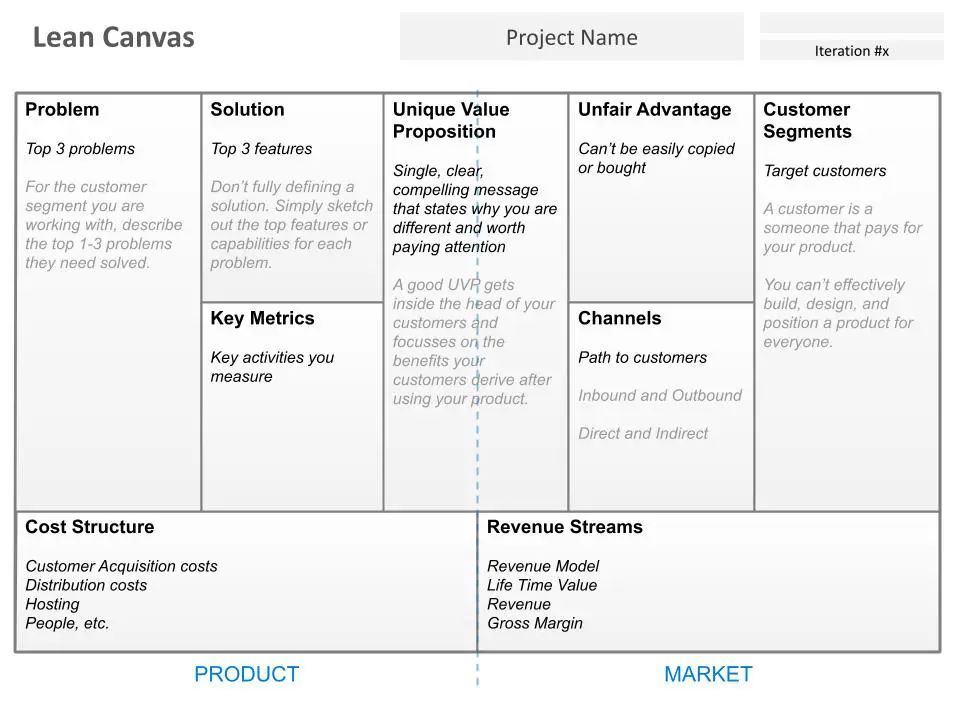The Lean Startup Canvas: Building Your Startup’s Roadmap to Success
Starting a new venture is an exhilarating journey, but it can also be a bumpy ride filled with uncertainties.
That’s where the Lean Startup Canvas comes in.
In this blog post, we’ll dive deep into the concept of the Lean Startup Canvas, its importance, and how it can guide you in building a successful startup.
So, fasten your seatbelts, and let’s embark on this exciting adventure!
Understanding the Lean Startup Canvas
? Imagine the Lean Startup Canvas as a roadmap that helps you navigate the intricate terrains of your startup’s development.
It is a strategic management tool that provides a framework for identifying, testing, and validating your business assumptions.
Inspired by the Business Model Canvas, the Lean Startup Canvas focuses specifically on the unique challenges faced by startups.
The Key Elements of the Lean Startup Canvas
? To effectively utilize the Lean Startup Canvas, let’s explore its key elements:
- Problem: Every successful startup begins by identifying a problem that needs solving. This section of the canvas helps you define the pain points your target customers experience.
- Solution: Here, you’ll outline your proposed solution to the identified problem. This part allows you to brainstorm and iterate on your ideas to find the most viable solution.
- Key Metrics: Metrics are essential for measuring progress and success. Determine the key performance indicators (KPIs) that will help you track and evaluate your startup’s growth.
- Unique Value Proposition (UVP): Your UVP highlights the unique advantage your product or service offers to customers. It should clearly communicate the value you bring to the table and differentiate you from competitors.
- Channels: Consider the channels through which you will reach and engage with your target audience. Think about online platforms, social media, partnerships, and other distribution channels that align with your target market.
- Customer Segments: Identify your ideal customer segments and understand their needs, preferences, and behaviors. Tailoring your product or service to specific customer segments enhances your chances of success.
- Unfair Advantage: This section highlights the unique strengths or advantages your startup possesses, which make it difficult for competitors to replicate. It could be proprietary technology, exclusive partnerships, a strong network, or deep industry expertise. Your unfair advantage sets you apart and gives you a competitive edge.
- Cost Structure: Assess the costs associated with running your startup. This includes both fixed and variable costs such as production, marketing, and operational expenses.
- Revenue Streams: Define how your startup will generate revenue. Explore different monetization strategies, such as subscription models, one-time purchases, or freemium options.

The Lean Startup Canvas in Action
? Now that we have a grasp of the key elements, let’s see how the Lean Startup Canvas works in practice.
Consider a hypothetical example of a startup called “FreshBites” aiming to revolutionize the food delivery industry.
- Problem: FreshBites identifies that busy professionals struggle to find healthy and convenient meal options due to time constraints.
- Solution: FreshBites plans to offer a mobile app that connects users with local chefs who create nutritious meals delivered right to their doorstep.
- Key Metrics: FreshBites tracks customer acquisition, customer retention, and average order value as key metrics to gauge their business performance.
- Unique Value Proposition (UVP): FreshBites offers a diverse menu of chef-prepared, healthy meals, personalized to individual dietary preferences and delivered quickly.
- Channels: FreshBites plans to utilize social media advertising, food influencers, and partnerships with fitness centers to reach their target audience.
- Customer Segments: FreshBites focuses on health-conscious professionals, particularly those who value convenience and prioritize their well-being.
- Unfair Advantage: FreshBites leverages its partnerships with local organic farms, ensuring the highest quality ingredients for their meals. This direct supply chain provides them with a competitive advantage in terms of freshness, taste, and sustainable sourcing.
- Cost Structure: FreshBites considers costs such as ingredient sourcing, meal preparation, delivery logistics, and marketing expenses.
- Revenue Streams: FreshBites plans to generate revenue through meal subscriptions and a commission-based fee from each order
Scaling and Iterating with the Lean Startup Canvas
? The Lean Startup Canvas is not a one-time exercise but rather a tool for continuous improvement and iteration.
As you gather feedback, learn from your customers, and adapt to market dynamics, you can update your canvas accordingly.
Here are some tips to help you scale and iterate effectively:
- Minimum Viable Product (MVP): The concept of an MVP is central to the Lean Startup methodology. It involves creating a simplified version of your product or service with just enough features to gather feedback and validate your assumptions. By launching your MVP early, you can learn from real user interactions and iterate based on their needs and preferences.
- Build-Measure-Learn Feedback Loop: The Lean Startup approach emphasizes the importance of a continuous feedback loop. Collect data, measure the impact of your experiments, and learn from the results. Use this knowledge to refine your solution and make informed decisions for future iterations.
- Pivot or Persevere: Based on the insights gained from the feedback loop, be open to pivoting if necessary. A pivot involves making a significant change to your business model, product offering, or target market. It’s crucial to assess whether you should persevere with your current strategy or adapt based on market demands.
- Experimentation and Hypothesis Testing: The Lean Startup methodology encourages experimentation and hypothesis testing. Formulate clear hypotheses about your business assumptions and design experiments to validate or invalidate them. Embrace a culture of learning from both successes and failures, as they provide valuable insights for future decision-making.
- Continuous Customer Engagement: Stay connected with your customers throughout the startup journey. Engage them in surveys, interviews, and usability tests to understand their evolving needs and expectations. This ongoing dialogue will enable you to align your product or service with their preferences, ensuring customer satisfaction and loyalty.
Benefits of the Lean Startup Canvas
? The Lean Startup Canvas offers several benefits that can significantly impact your startup’s success:
- Strategic Focus: The canvas provides a structured framework to define your startup’s vision, mission, and key components. It helps align your team around a shared understanding of the business model and strategy, fostering effective collaboration.
- Reduced Risk and Cost: By systematically testing assumptions and validating your ideas through experimentation, the Lean Startup Canvas helps minimize the risks associated with launching a new venture. It enables you to make data-driven decisions and avoid costly mistakes.
- Agility and Adaptability: The Lean Startup approach encourages flexibility and adaptability. The canvas allows you to respond quickly to market feedback, iterate on your product or service, and pivot if needed. This agility is crucial in a fast-paced and dynamic startup environment.
- Efficient Resource Allocation: By focusing on the key elements of your business model, the canvas helps optimize resource allocation. It ensures that you prioritize activities and investments that directly contribute to the success of your startup.
Related Posts
Conclusion
? The Lean Startup Canvas is a powerful tool that empowers entrepreneurs to navigate the uncertainties of building a startup.
By systematically addressing the key elements, testing assumptions, and iterating based on customer feedback, you can increase your chances of creating a successful and sustainable business.
Remember, the Lean Startup Canvas is not a magic formula, but rather a guide that encourages a lean and iterative approach.
Embrace the journey, learn from failures, and celebrate successes along the way. Your startup’s success lies in your ability to adapt, innovate, and deliver value to your customers.
So, grab your canvas and start mapping out your path to startup greatness!
??? Happy canvasing and best of luck on your entrepreneurial adventure!
















